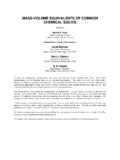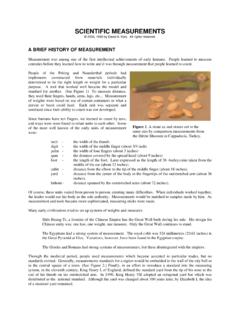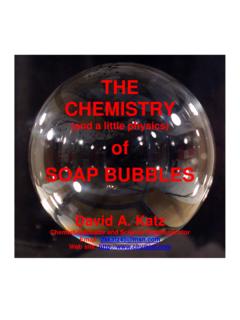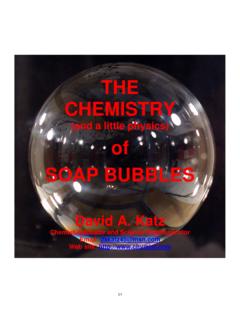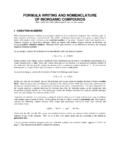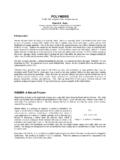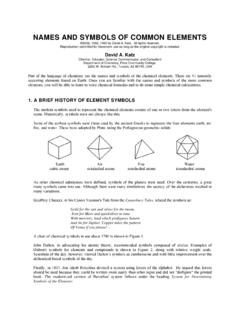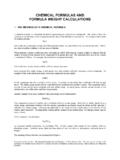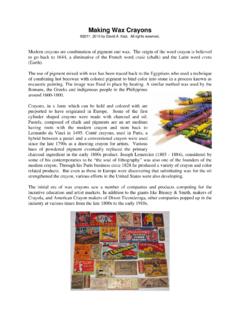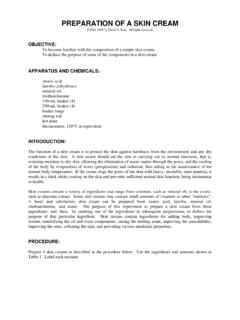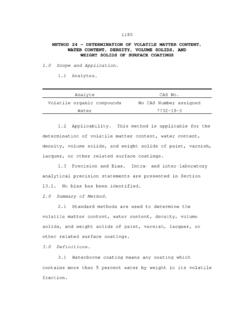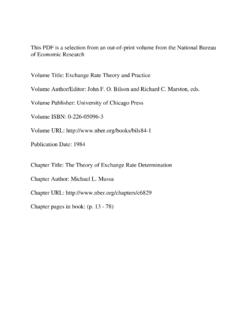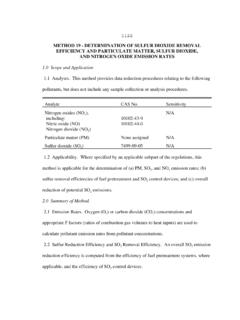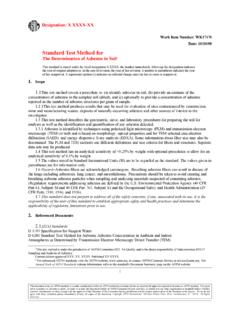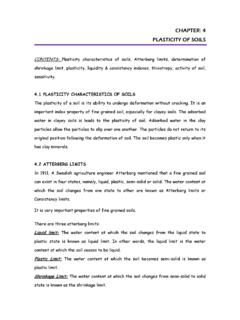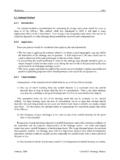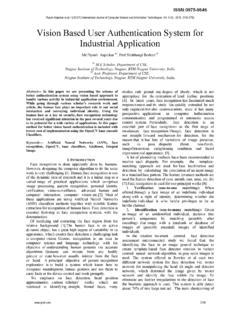Transcription of Determination of the Half-Life of Potassium-40 - …
1 Determination of the Half-Life of Potassium-40 2012 by David A. Katz. All rights reserved. David A. Katz Department of Chemistry Pima Community College, 2202 W. Anklam Rd. Tucson, AZ 85709, USA Introduction All matter is made up of small particles which we call atoms. The atoms of each element are composed of two parts, a nucleus, at the center of the atom, and energy levels around the nucleus. The main subatomic particles that make up the atoms are protons and neutrons, found in the nucleus, and electrons which occupy the energy levels outside the nucleus. Each chemical element has a unique identity that is determined by the number of protons in its nucleus.
2 Since protons have a positive charge, and like charges repel each other, to hold the protons together there are neutrons which are also located in the nucleus. For most light elements, the number of protons and neutrons are approximately equal, but as the nuclear charge of the atoms increase, the number of neutrons increases by a larger amount in order to stabilize the nucleus. For example, an atom of helium normally contains 2 protons and 2 neutrons in its nucleus, an atom of potassium normally contains 19 protons and 20 neutrons in its nucleus, and an atom of uranium usually contains 92 protons and 146 neutrons in its nucleus. There is a large number of atoms of elements that have the same number of protons, but different numbers of neutrons in their nuclei.
3 Such atoms are known as isotopes. Isotopes of an element generally have the same physical and chemical properties, except they have a different atomic mass. Some of the isotopes of some atoms, however, are not stable and, within some time period, which can range from microseconds to millions of years, their nucleus will fall apart, or disintegrate, losing a small piece. Such atoms are said to be radioactive. The disintegration is called nuclear or radioactive decay. No matter what the element is, when natural nuclear disintegration takes place, two types of particles are most commonly emitted: alpha particles ( ) or beta particles ( ). These are usually accompanied by a third type of radiation in the form of gamma ( ) rays.
4 Alpha particles, , are positively charged and are identified as helium nuclei. They are relatively large in mass and interact strongly with matter, being absorbed by as little as a sheet of paper. Beta particles, , are negatively charged and are identified as fast electrons. They are small in mass and interact less with matter than particles and can easily penetrate paper and cardboard, but are absorbed by metal sheets. The third type of radiation, gamma rays, , are not particles but very high energy photons, similar to x-rays, but more energetic. They interact with matter much less strongly than do alpha and beta particles and consequently their penetrating power is very high.
5 In this experiment, you will determine the background radiation, the Half-Life of a radioactive element, and the Half-Life of Potassium-40 .. SAFETY PRECAUTIONS for Handling Radioactive Materials The samples and materials used in this experiment are low level radioactive emitters and are considered to be safe quantities of radioactive substances. In this experiment, salt substitute, a food additive, is used. We will, however, treat this material with the respect due to any radioactive substance. Do not handle radioactive materials unless you are required to do so. They should be removed from their containers when needed for a procedure, taken to the work area, and then returned to their containers or disposed of when the procedures are completed.
6 Always handle radioactive materials with extreme care using the smallest quantity necessary for your experiment. Remember that you cannot see or feel the radiation coming from that innocent looking sample, you will only feel the effects at a later time - then, it is too late! Always wear gloves and any other applicable safety clothing when working with radioactive materials. For these procedures, disposable gloves will be used. Any pregnant students, or individuals who are trying to become pregnant, should avoid radioactive materials, no matter how safe they claim to be. Please inform your instructor so you may be excused from the laboratory for this experiment.
7 When removing disposable gloves, hold them at the cuff and remove them turning them inside out so that any traces of radioactive materials are on the inside of the glove. Do not reuse the gloves. Dispose of the gloves as directed. Do not eat, drink, chew gum, or wear cosmetics when working with radioactive materials. All edible materials are banned from areas where radioactive materials are used. Any cut or wound arising during work with radioactive materials should get immediate medical attention. All radioactive wastes should be stored in appropriately labeled containers until properly stored or disposed of. All personnel must wash their hands and face and survey their person for any contamination before leaving the laboratory.
8 The laboratory should be surveyed for any contamination after cleaning up. DISPOSAL All waste materials must be placed in the properly labeled containers in the laboratory. All glassware used to hold radioactive isotopes must be placed in the location provided near the waste containers. How to Use the Aware Electronics Model RM-60 Micro Roentgen Radiation Monitor Attach the Radiation Monitor to the laboratory laptop computer using the appropriate adapter. Click on the AW-RADW icon on the desktop.. On the opening screen, click on Alarm Options. Click on Alarm Level and set the Alarm Level to zero. Then click OK. On the Alarm Options menu, click on Points to Average. Set the Alarm Rad Points to 1.
9 Click OK. On the Alarm Options menu, click on Alarm Sound volume . Set the Alarm Sound Off.. On the Main Screen, click on Rad Options. Click on Geiger Click Options and turn Geiger Click On. On the Rad Options menu, click on TBU (Time Base Unit). Set the TBU to 30 seconds. Click OK. You are now ready to measure the radiation of your samples.. Part 1. Determination of the Background Radiation There is radiation all around us. It comes from the sun, from distant stars or other sources in space, from radioactive isotopes in the air, and from radioactive isotopes in the soil. This radiation will vary with your location on the Earth, but no place is 100% nuclear radiation free.
10 All this radiation is known as background radiation. In order to measure radioactivity of our samples, the background radiation must be determined. Materials Needed: Aware Electronics Geiger counter tube interfaced with a laboratory computer. (See Figure 1.) Stand for the Aware Electronics Geiger tube. (See Figure 2) Procedure: Remove all radioactive materials from your work area. Set the Geiger tube apparatus in a stand. Using the computer program for the Geiger tube, set the time interval for 60 seconds. On the Main Screen, click on Rad Collection. Select Express Start Collection of Rad Data. On the next screens either press on OK or Save. No other entries are needed.
